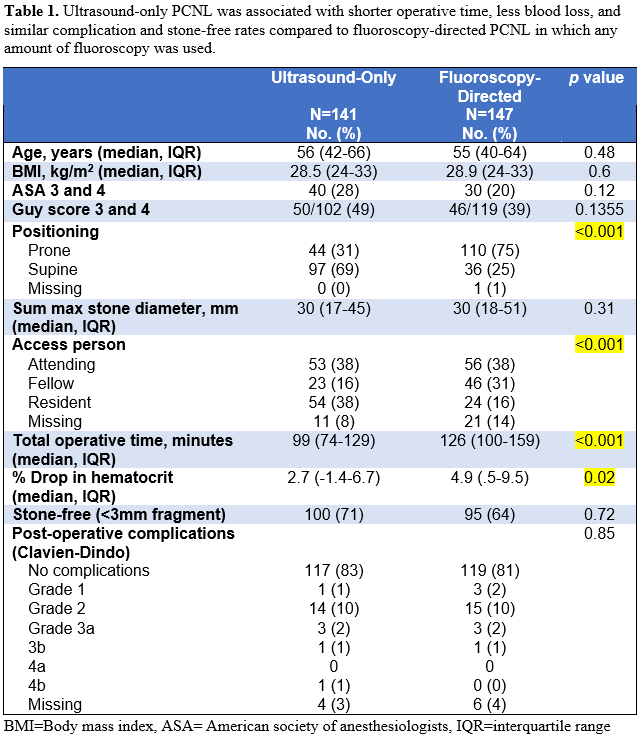Back
Poster, Podium & Video Sessions
Moderated Poster
MP44: Stone Disease: Surgical Therapy (including ESWL) III
MP44-03: Ultrasound-Only Percutaneous Nephrolithotomy is Safe and Effective Compared to Fluoroscopy-Directed PCNL
Sunday, May 15, 2022
1:00 PM – 2:15 PM
Location: Room 228
Nizar Hakam*, Gregory Hosier, Xavier Cortez, Fadl Hamouche, Leslie Charondo, Heiko Yang, Carter Chan, Kevin Chang, David Bayne, Marshall Stoller, Thomas Chi, San Francisco, CA
Poster Presenter(s)
Introduction: Use of ultrasound guidance for percutaneous nephrolithotomy (PCNL) access has gained popularity. However, reports on ultrasound-only PCNL, in which ultrasound is used for all steps of the procedure, are limited as fluoroscopy is often used for tract dilation and to check for residual stone fragments. The study goal was to compare outcomes for ultrasound-only PCNL compared to fluoroscopy-directed PCNL.
Methods: Prospectively collected data from the Registry for Stones of the Kidney and Ureter (ReSKU) database was reviewed for all patients who underwent PCNL at one academic center from 2015-2021. Primary outcomes were complications (Clavien-Dindo classification) and stone free rates (no residual fragments =3 mm) compared between those who underwent ultrasound-only PCNL and fluoroscopy-directed PCNL in which any amount of fluoroscopy was used.
Results: 141 patients who underwent ultrasound-only PCNL and 147 who underwent fluoroscopy-directed PCNL were identified. Mean maximum summative stone diameter was 30 mm and 44% were Guy score 3 or 4. Stone and patient characteristics were similar between both groups (Table 1). There was no difference in complication rates (15% vs. 16%, p=0.87) or stone free status (71% vs 65%, p=0.72) between those who underwent ultrasound-only PCNL and fluoroscopy-directed PCNL respectively. Ultrasound-only PCNL was associated with shorter operative time (median 99.5 minutes vs 126 minutes, p<0.001), lower percent drop in hematocrit (2.68% vs 4.91%, p=0.02), higher success rate of access achieved by resident (38.3% vs 16.3%, p<0.001) and more frequent use of supine positioning (68.8% vs 24.5%, p <0.001) compared to fluoroscopy-directed PCNL. After adjusting for BMI, ASA, stone size, and stone complexity by Guy score, ultrasound-only PCNL was not associated with any increased odds of complications (odds ratio [OR] 0.706, 95% confidence interval [CI] 0.305 – 1.635, p=0.416) or residual stone fragment =3 mm (OR 0.989, 95% CI 0.524 – 1.866, p=0.972) compared to fluoroscopy-directed PCNL.
Conclusions: Ultrasound-only PCNL is safe and achieves similar stone free rates compared to fluoroscopy-directed PCNL with added benefits of shorter operative time, less blood loss, and avoidance of radiation.
Source of Funding: None

Methods: Prospectively collected data from the Registry for Stones of the Kidney and Ureter (ReSKU) database was reviewed for all patients who underwent PCNL at one academic center from 2015-2021. Primary outcomes were complications (Clavien-Dindo classification) and stone free rates (no residual fragments =3 mm) compared between those who underwent ultrasound-only PCNL and fluoroscopy-directed PCNL in which any amount of fluoroscopy was used.
Results: 141 patients who underwent ultrasound-only PCNL and 147 who underwent fluoroscopy-directed PCNL were identified. Mean maximum summative stone diameter was 30 mm and 44% were Guy score 3 or 4. Stone and patient characteristics were similar between both groups (Table 1). There was no difference in complication rates (15% vs. 16%, p=0.87) or stone free status (71% vs 65%, p=0.72) between those who underwent ultrasound-only PCNL and fluoroscopy-directed PCNL respectively. Ultrasound-only PCNL was associated with shorter operative time (median 99.5 minutes vs 126 minutes, p<0.001), lower percent drop in hematocrit (2.68% vs 4.91%, p=0.02), higher success rate of access achieved by resident (38.3% vs 16.3%, p<0.001) and more frequent use of supine positioning (68.8% vs 24.5%, p <0.001) compared to fluoroscopy-directed PCNL. After adjusting for BMI, ASA, stone size, and stone complexity by Guy score, ultrasound-only PCNL was not associated with any increased odds of complications (odds ratio [OR] 0.706, 95% confidence interval [CI] 0.305 – 1.635, p=0.416) or residual stone fragment =3 mm (OR 0.989, 95% CI 0.524 – 1.866, p=0.972) compared to fluoroscopy-directed PCNL.
Conclusions: Ultrasound-only PCNL is safe and achieves similar stone free rates compared to fluoroscopy-directed PCNL with added benefits of shorter operative time, less blood loss, and avoidance of radiation.
Source of Funding: None


.jpg)
.jpg)
